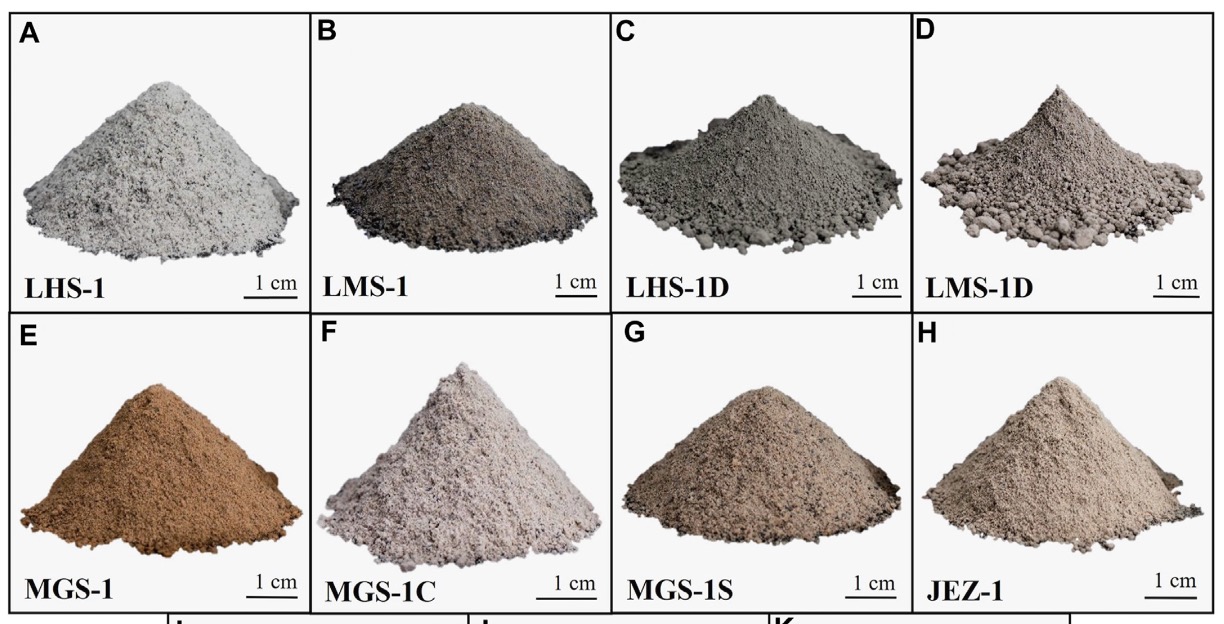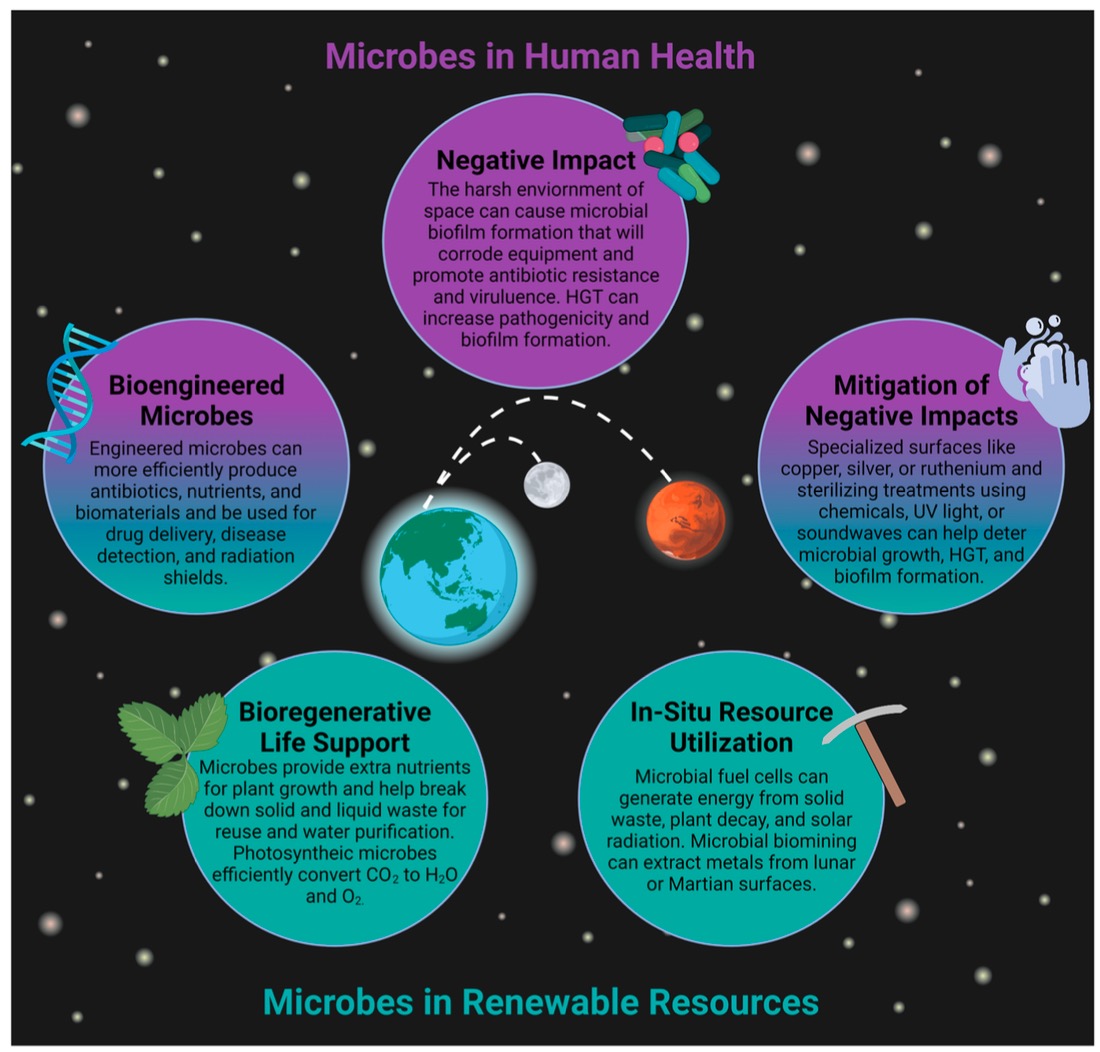2 Simulating Extraterrestrial Soils: Lunar and Martian Regolith Analogs
Hugo Castillo
Learning Objectives
- Demonstrate proper aseptic techniques and experimental design by preparing bacterial cultures in simulated lunar and Martian regolith media, ensuring contamination-free growth conditions.
- Evaluate microbial growth and metabolism by comparing bacterial responses (e.g., colony formation, biomass yield, or metabolic activity) in regolith-based substrates versus standard laboratory media.
- Analyze the implications of regolith–microbe interactions for astrobiology and space exploration, including their potential roles in bioregenerative life support, in-situ resource utilization (ISRU), and planetary protection.
Introduction
Regolith refers to the loose, fragmented material covering solid planetary surfaces, formed through billions of years of meteorite impacts, solar radiation exposure, and, in the case of Mars, volcanic activity and wind erosion (Mills et al 2022). Unlike terrestrial soils, regolith lacks organic matter and contains sharp, abrasive particles, with lunar regolith rich in silicates and nanophase iron, and Martian regolith characterized by basaltic materials and toxic compounds such as perchlorates (Xiong et al 2024, Rzymski et al 2024). Despite these challenges, regolith is considered a key resource for future space missions under the concept of in-situ resource utilization (ISRU). Regolith could serve as a construction material for habitats and landing pads, as well as provide radiation shielding, critical in the absence of a protective magnetic field on both the Moon and Mars. It also has potential for extracting oxygen and water, either bound in mineral forms or as ice, and it could be transformed into a growth medium for plants to support human life (Hossain et al 2025, Neukhart 2024, Zhang et al 2023 and Duri et al 2022). However, using regolith for biological purposes presents significant challenges due to its extreme pH, low nutrient content, poor water retention, and potential toxicity to plants and microbes. Table 1 compares some physical and chemical characteristics of Lunar and Martian regolith with soil. As a result, ongoing research is focused on understanding how to engineer or biologically amend regolith to support microbial activity and plant growth, laying the groundwork for sustainable life-support systems. Studying regolith is, not only essential for understanding planetary geology but also a fundamental step toward enabling human settlement beyond Earth.

Table 1. Lunar and Martian regolith physical characteristics, compared to soil.
Lunar and Martian Regolith and simulants
Understanding the chemical composition of Lunar and Martian regolith (table 2) not only informs us about the geological history and environmental conditions of each planet/moon, but it also plays an important role in planning sustainable long-term missions. On Earth, soil composition affects agriculture, ecosystems, and construction. On the Moon and Mars, the regolith must serve as a construction material, as a source of essential elements like oxygen and water, as a protective layer against radiation, and even a potential growth medium for plants. Understanding these materials at the elemental level is therefore essential to adapt “hostile” extraterrestrial environments into habitable spaces for future explorers.

Table 2. Lunar and Martian regolith elmental composition, compared to soil.
Since actual lunar and Martian regolith is scarce and difficult to obtain, simulants are essential to test technologies and do research on Earth in preparation for future space missions. These materials are used in a wide range of applications, including evaluating construction techniques, developing life support systems, testing in-situ resource utilization (ISRU), and studying plant growth potential in space environments. Different types of simulants have been created to reflect specific regions or characteristics of planetary surfaces: for example, JSC-1A and NU-LHT are designed to simulate lunar mare and highland soils, respectively, while MGS-1 and MMS are formulated to resemble average Martian regolith. While no simulant can perfectly replicate the exact conditions of their extraterrestrial counterparts—such as the presence of nanophase iron or perchlorates—they provide a critical foundation for scientific advancement and mission readiness. Simulants are manufactured by space agencies and companies such as Space Resource Technologies (https://spaceresourcetech.com).
 Figure 1. Lunar and Martian regolith simulates (Space Technologies), adapted from Long-Fox and Britt, 2023. A-D Lunar regolith simulants: LHS and LMS are formulated based on the composition of highland (elevated areas, covering ~83% of lunar surface) and mare (low-lying basins, covering ~17% of surface) samples, respectively. E-H Martian regolith simulants: MGS and JEZ are formulated based on the composition of average Martian and Jezero crater regions, respectively.
Figure 1. Lunar and Martian regolith simulates (Space Technologies), adapted from Long-Fox and Britt, 2023. A-D Lunar regolith simulants: LHS and LMS are formulated based on the composition of highland (elevated areas, covering ~83% of lunar surface) and mare (low-lying basins, covering ~17% of surface) samples, respectively. E-H Martian regolith simulants: MGS and JEZ are formulated based on the composition of average Martian and Jezero crater regions, respectively.
Microbes survival and adaptation to regolith
The survival of microbes in lunar and Martian regolith is an essential area of research in astrobiology and space biology, particularly to support the provision of the elements required for long-term space missions, such as the production of oxygen and food. While growth in native, un-modified regolith is unlikely due to the extreme environmental conditions, its amendment with organic matter and water to modify its physical and chemical characteristics could increase the survivability and establishment of different species. Martian regolith, though toxic and dry, contains perchlorates and lacks organic nutrients, yet studies have shown that species such as Bacillus subtilis, Deinococcus radiodurans, and some cyanobacteria can survive—and even grow—when provided with water, light, and CO₂. These microbes use mechanisms like dormancy, spore formation, biofilm production, and protective pigments to withstand harsh conditions including high radiation and desiccation. In contrast, lunar regolith is even more challenging due to its complete lack of volatile organic compounds, nutrients, and extreme temperatures. No viable microbes have been found in lunar samples, and the environment is considered biologically inert. However, in simulated environments, some microorganisms have demonstrated short-term survival. This research has significant implications for planetary protection, as it helps assess the risk of contaminating celestial bodies with Earth life, and for in-situ resource utilization (ISRU), where microbes may one day assist in oxygen production, bioremediation, or regolith conditioning to support plant growth and human habitats.

Taken from Koehle et al 2023
Giuseppe, D. L., Giandonato, C. A., Youssef, R., Simona, V., Mario, P., Stefania, D. P., & Paola, A. (2022). The potential for lunar and Martian regolith simulants to sustain plant growth: A multidisciplinary overview. Frontiers in Astronomy and Space Sciences, 8, Article 747821. https://doi.org/10.3389/fspas.2021.747821
Hossain, S. S., & Bullard, J. W. (2025). Sintering of lunar regolith: A review. Acta Astronautica, 231, 153–174. https://doi.org/10.1016/j.actaastro.2023.09.009
Koehle, A. P., Brumwell, S. L., Seto, E. P., et al. (2023). Microbial applications for sustainable space exploration beyond low Earth orbit. npj Microgravity, 9, 47. https://doi.org/10.1038/s41526-023-00285-0
Long-Fox, J. M., & Britt, D. T. (2023). Characterization of planetary regolith simulants for the research and development of space resource technologies. Frontiers in Space Technologies, 4, 1255535. https://doi.org/10.3389/frspt.2023.1255535
Mills, J. N., Katzarova, M., & Wagner, N. J. (2022). Comparison of lunar and Martian regolith simulant-based geopolymer cements formed by alkali-activation for in-situ resource utilization. Advances in Space Research, 69(1), 761–777. https://doi.org/10.1016/j.asr.2021.09.049
Neukart, F. (2024). Towards sustainable horizons: A comprehensive blueprint for Mars colonization. Heliyon, 10(4), e26180. https://doi.org/10.1016/j.heliyon.2024.e26180
Rzymski, P., Losiak, A., Heinz, J., Szukalska, M., Florek, E., Poniedziałek, B., Kaczmarek, Ł., & Schulze-Makuch, D. (2024). Perchlorates on Mars: Occurrence and implications for putative life on the Red Planet. Icarus, 421, 116246. https://doi.org/10.1016/j.icarus.2024.116246
Xiong, M., Wu, Y., Yao, W., Chen, Z., Yu, Y., Li, X., Yan, P., Li, X., & Zeng, X. (2024). The formation mechanisms of np-Fe in lunar regolith: A review. Materials, 17(23), 5866. https://doi.org/10.3390/ma17235866
Zhang, P., Dai, W., Niu, R., Zhang, G., Liu, G., Liu, X., Bo, Z., Wang, Z., Zheng, H., Liu, C., et al. (2023). Overview of the lunar in situ resource utilization techniques for future lunar missions. Space: Science & Technology, 3, 0037.D. https://doi.org/10.34133/space.0037
Suggestions to learn more about the survival of microbes in Lunar and Martian regolith
Verseux, C., Baqué, M., Lehto, K., de Vera, J.-P., Rothschild, L. J., & Billi, D. (2016). Sustainable life support on Mars – The potential roles of cyanobacteria. International Journal of Astrobiology, 15(1), 65–92. https://doi.org/10.1017/S147355041500021XCambridge University Press & Assessment 1Nature 1
Horneck, G., Moeller, R., Cadet, J., Douki, T., Mancinelli, R. L., Nicholson, W. L., Panitz, C., Rettberg, P., Spry, A., & Stackebrandt, E. (2012). Resistance of bacterial endospores to outer space for planetary protection purposes—Experiment PROTECT of the EXPOSE-E mission. Astrobiology, 12(5), 445–456. https://doi.org/10.1089/ast.2011.0737Wikipedia
Moeller, R., Raguse, M., Leuko, S., Berger, T., Hellweg, C. E., Fujimori, A., Okayasu, R., & Horneck, G. (2019). Live on air: Survival of Bacillus subtilis spores exposed to Mars-like surface conditions and simulated space vacuum on the International Space Station. Frontiers in Microbiology, 10, 1333. https://doi.org/10.3389/fmicb.2019.01333
Billi, D., Verseux, C., Baqué, M., Rabbow, E., & de Vera, J.-P. (2019). A desert cyanobacterium under simulated Mars-like conditions in low Earth orbit: Implications for the habitability of Mars. Astrobiology, 19(2), 158–169. https://doi.org/10.1089/ast.2017.1807
Vogler, R., Pettersson, G. M., Brouns, S. J. J., Rothschild, L. J., Cowley, A., & Lehner, B. A. E. (2020). Mining Moon & Mars with microbes: Biological approaches to extract iron from lunar and Martian regolith. Planetary and Space Science, 184, 104850. https://doi.org/10.1016/j.pss.2020.104850
Perchlorates are chemical compounds that contain the perchlorate ion (ClO₄⁻), a chlorine atom surrounded by four oxygen atoms in a tetrahedral structure. They are highly oxidizing salts, commonly formed with metals like sodium, potassium, magnesium, or calcium.
ISRU refers to the practice of using local materials found on the Moon, Mars, asteroids, or other celestial bodies to support human and robotic space missions. Instead of launching all supplies from Earth—which is costly and logistically complex—ISRU enables astronauts to "live off the land" by producing critical resources on-site.
Life support systems are critical technologies that provide and maintain the essential conditions for human survival in space or on other planetary bodies. These systems regulate the environment inside spacecraft, space habitats, or extraterrestrial outposts to keep astronauts alive, healthy, and functional in environments that are otherwise hostile to life.
Nanophase iron (np-Fe⁰) refers to extremely small metallic iron particles, typically less than 100 nanometers in size, found embedded in lunar regolith and other airless planetary surfaces. These particles are not naturally abundant on Earth but are a common byproduct of space weathering processes on the Moon and possibly other bodies like asteroids and Mercury.
